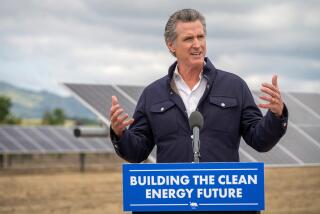Emissions auction to raise research funds
- Share via
A “cap-and-trade” system for reducing carbon emissions from power plants and other industrial facilities would cut total emissions 14% below 2005 levels by 2020 and 83% below 2005 by 2050.
The proposal -- potentially one of the most far-reaching elements in the budget blueprint -- is unusually detailed. That suggests that President Obama will be less willing to negotiate with Congress over the specifics of his global warming strategy.
Under the plan, the government would issue permits setting emissions maximums -- caps -- for individual facilities. The caps would tighten annually to achieve the overall federal goals.
Under the “trade” part of the plan, plants that exceeded their emissions cap could buy permits at government auction to cover the excess, either from the government or from companies that did not reach their maximum.
Obama’s budget assumes that by 2012, auctions will generate revenue averaging $15 billion a year to go toward renewable-energy research.
Revenue beyond that “will be returned to the people, especially vulnerable families, communities and businesses to help the transition to a clean-energy economy,” his blueprint says.
Critics of the plan pointed out that, in the short run at least, the permit requirements would probably raise costs for industry.
The top House Republican, John A. Boehner of Ohio, said the plan would increase taxes “on all Americans who drive a car, who have a job, who turn on a light switch.”
But the administration argues that action cannot be delayed on climate change and that, over time, the plan will help the economy recover and grow again.
-- Jim Tankersley
More to Read
Sign up for Essential California
The most important California stories and recommendations in your inbox every morning.
You may occasionally receive promotional content from the Los Angeles Times.










